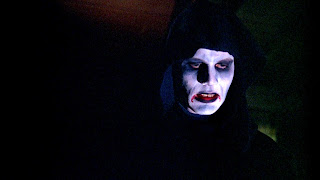Text © Richard
Gary / Indie Horror Films, 2021
Images from
the Internet
Demented (aka The Demented)
Directed by Nigel
Hartwell
New Blood
Entertainment; Flawless Video Creations;
Gate Three Films; Homemade Pie Productions; KBI Productions
96 minutes, 2021
www.newbloodentertainment.com/newblood_demented.html
Just before its release, the film made a subtle title change, from The Demented, as it is currently listed on IMDB, to just Demented, so as not to be confused with another film dealing with zombies with the same name released in 2013. This should also not be confused with the I Spit on Your Grave-ish cult classic Demented (1980, co-starring Harry Reams). So ends the history lesson.
This Canadian film is quite different that those others in that this falls well into the category of torture porn, with a supernatural touch. And in an extremely micro-budget way.
 |
| Cheyenne Ennis |
Lovebirds Senica (Dakota House) and Amanda (Cheyenne Ennis, giving a brave performance) go up to Senica’s cottage on the lake (filmed at Parry Sound, Ontario, about 2 hours north of Toronto). After dropping a ring on her, they spend the night. When Senica awakes, Amanda is gone. According to a police detective (the ever-fun Felissa Rose), so are her parents, and he’s the central person of interest.
Meanwhile, somewhere there is a room where women are systematically tortured and snuffed for the Dark Web (it’s always the Dark Web, right?) by a burly guy dressed in black, including a bullet-proof vest, and a leather hood. His voice is digitally manipulated, and honestly, I can only make out about half of what he says.
 |
| Dakota House |
We watch as he’s a-rapin’ (with his pants all the way on and her underwear intact) and a-chokin’ and a-tauntin’ his chained-to-a-bed victims. We see the room through his video camera, a fuzzy black-and-white CCTV on a celling corner, and whichever lens the film’s cameraperson is using to fill in the gaps and keep these scenes from being “found footage” style.
There is also some playing with time, with numerous flashbacks to various periods and present day, making the narrative timeline a bit confusing for a while. In one of these vignettes (past? present? future?), Amanda is a chainee, abused by the dark and mysterious man (though at 30 minutes in, I have a guess on who it may be; I’ll let you know if I’m right, but not who it is, okay? No spoilers).
Between the patterns of abuse, Amanda is visited by knowing spirits (including one played by wrestler Angel Williams), who are helpless to aid her, but communicate quite easily. Don’t get me wrong, this supernatural element is actually what made the film for me. The violence compared to most torture porn is relatively mild and mostly threats (and yes, much full-dressed raping).
But the rules of the film change with Amanda. Her accomplishments are the closest this comes to empowering women (not counting that the main authority figure is the police detective). Women generally are seen as torture victims and strippers. Misogyny? Maybe, but it felt good to have these women get some of their umph back, a lot of good it will do them in the long run.
 |
| Nigel Hartwell and Felissa Rose doing her iconic Angela face |
There is a lot of topless women (did I mention the strippers?), and nothing real to talk about in the blood department. There are some cheesy CGI effects at a point, but I believe it was meant to be that way. Y’see, from the way they use scratchy rolling noise on some of the camera images (though new equipment) made to look like VHS in the 1980s would explain the ‘80s look of the company’s logo at the beginning of the film.
The film is overlong at 96 minutes, but there is easily quite a bit that could be excised and not lose any of the story. For example, the “torment” scenes are incredibly mild considered next to something like the Hostel or Saw franchises, but they are on for what feels like a really long time of just the killer yakking away in his hard to make out digitized voice. Too many of the scenes and shots – especially the punishment ones – just seem too “samey,” in part due to the static cameras in the torture room
The acting is okay, but nothing to write home to mother about, though as always, Rose easily holds her own; the two main leads often don’t look like they are trying too hard, especially House, from whom I was expecting more. There are some really well-done shots, including some drone work, which was refreshing after the obvious green screen parts.
 |
| Ari Lehman, whose band performs during the final credits |
The production pattern is a bit different, but I’m not sure if some of it is intentional on the director’s part, a stylistic choice, or just a distance necessity (i.e., people recorded in different places made to look like they are together). Many times, especially in the police station scenes with Rose, it is pretty obvious that – despite some similar motifs on the walls that I am pretty sure are green-screened – the detective and two of the people she is interviewing are single shots and not in the same room. It seems like House doesn’t know which direction to look, often off to the wrong side of where the Detective would be standing. When she interviews a porn/snuff provider, Brad (Canadian wrestling champion Bret Hart), his acoustical tone is different than hers, and he also looks in the wrong direction. This “separation” with green screen and different sound is also employed with a bartender (by cameo-king Ari Lehman). When Amanda and Senica are introduced as a couple on the drive north, at first this single shot method was used in the car, but then finally a double shot.
One weird plot point to me is that Amanda’s parents are also missing, as it is a family thing with the bad guys. But this is not shown for any other victims. It feels like a pretty big plot can of worms hole that did not need to be opened in the first place.
Speaking of sound, there is an almost amusing moment when we hear a character’s thinking processes, and it was obviously recorded later in a studio by how well it sounds, but also that there is a comment when the actor obviously accidentally falls during the filming, and the narration goes, “Oh, that hurt.” I am so glad they put that in.
The extras are three music videos and three company trailers (including this film).
If I had my druthers,
I would like to see them take this film, re-edit it or have third party do it, and see where it goes. It has some nice potential, and I
would like to see that fulfilled. And for the record, I was way off on who was
the killer.


























